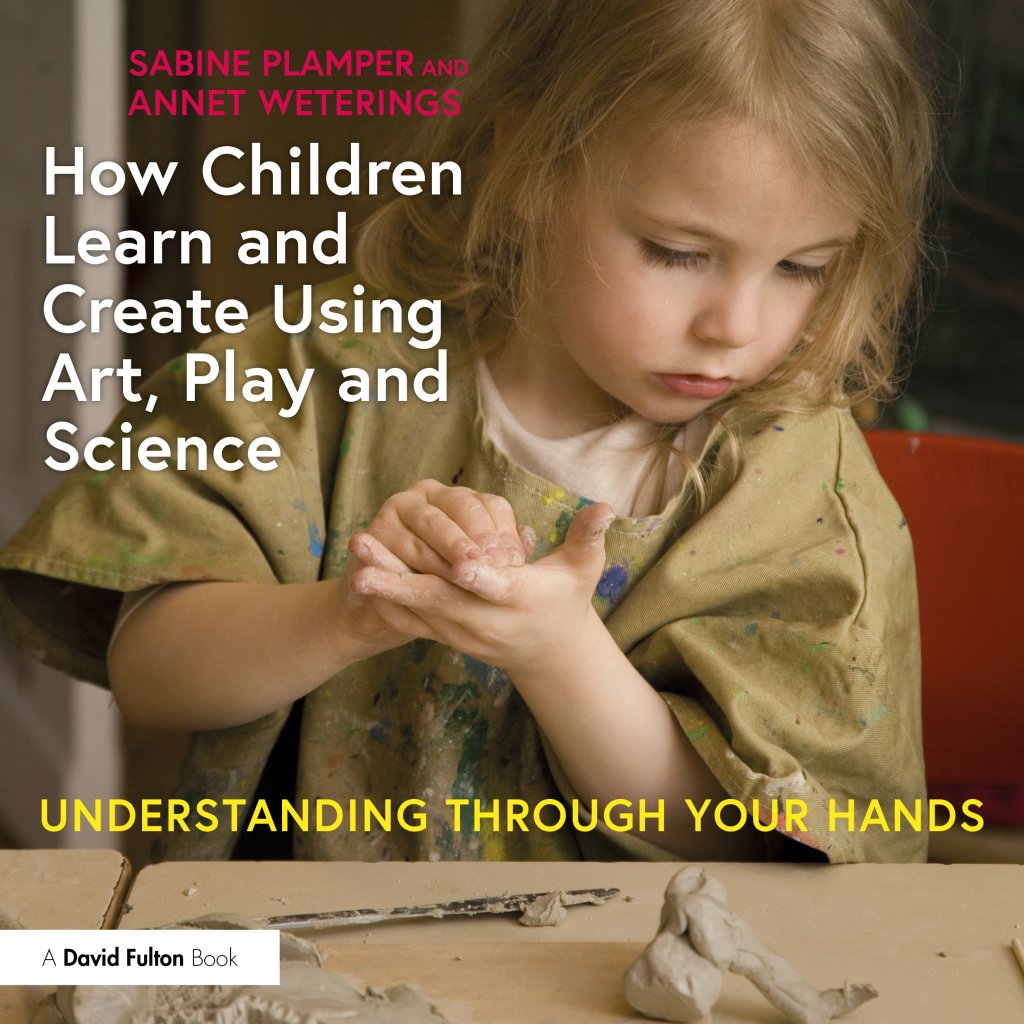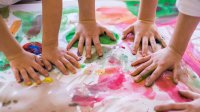Child-Directed Art Exploration in Preschool
Teachers can avoid making judgments about young children’s art, instead helping them imagine next steps and work through frustrations.
Supervising children in a non-judgemental way means not fussing about what they have made, but creating the optimum conditions for children to work and remain involved. It’s important not to speak of lovely, nice, beautiful or wonderful or any other aesthetic judgement, however difficult that is in practice. Children who hear that something is beautiful will want to hear this again and again, and they will become dependent on your opinion. The priority is for children to follow their interests, to research and discover. As you listen to them, the connections they make will give you a glimpse into their personal world. This can be a sensitive moment that makes them vulnerable, and therefore, the right/ wrong/beautiful label is simply not appropriate here.
Don’t disturb concentration
Giving children space to concentrate on their creative activities means not disturbing them. The saying ‘speech is silver but silence is golden’ often applies. This gives room for interaction between the children, too. Children will learn through watching each other and talking together.

Pitfalls to avoid when supervising children:
- What are you making? If a child makes connections whilst involved in making, they will let you know in their own time. They won’t be able to answer questions whilst in the middle of a creative process. Rather than asking questions, make a note of any information the child volunteers.
- Not listening to what a child tells you, of their own accord, about the material or how they are experiencing it.
- Comparing one child’s work with that of others. Everyone works in their own way, at their own pace and with their own visual language.
- Directing, by saying how it should be or what the intention is.
- Interfering with a child’s work: drawing, painting, colouring or sticking clay somewhere, while they are still at work, or giving pointers: that goes there. Or worse: taking over actions. Children are in charge of their own work!
- Allowing other adults to wander into the creative space with all sorts of questions or comments about lovely or ugly. This will disturb children’s concentration and process.
How and when you might ask questions
It is useful to know which questions to ask and when. Caution is required here, for to ask too many questions may signal to the child you want them to go in certain direction, or that you do not understand their work. A valid question is: ‘Would you like to tell me something about it?’ This gives a child the chance to say ‘No’. Good questions will help to sharpen the senses, and prompt stimulation and challenge (De Valck 2012).
- Offer help: ‘Do you need anything else?’
- Encourage them to focus: ‘Do you hear/see/feel/ taste/smell that too...?’
- Suggest a challenge: ‘How would it be if you...?'
- Invite them to expand on what you see: ‘Does it all turn the same way? What do you see?'
- Foster logical thinking: ‘What could you use to do that? What would happen if...?'
- Challenge them to solve a problem: ‘What could you use to make that?’
What can you do?
If explaining or directing, judging or asking closed questions is not on, adults often wonder what they can do. For example, you might:
- Pay attention to a child’s involvement. Be curious about what they are doing or thinking.
- Affirm what they are doing: ‘Gosh, you’re hard at work!’
- Look at their technique: ‘You have to be strong to cut, don’t you?’
- Draw attention to the materials: ‘How does that feel? Is it soft or rough?’
- Stay close to a child if they are having difficulty—do not underestimate the support your presence can provide. A child will feel seen and acknowledged, and perhaps dare to continue.
Avoid making a judgement about the product with older children too
Steering clear of judgements takes effort and can be difficult for adults. We’re so used to doing it, it’s almost a reflex. Especially when children ask for confirmation: ‘Nice, isn’t it?’—this makes sense, particularly if they are constantly being valued in this way. One way of dealing with this is to respond with another question: ‘Are you satisfied with it? That is what I find important.’
Children may be surprised at first by your response, but you may notice them passing on your words later in the day to other children. Genuine interactions of this sort help to create a positive culture, where children can develop their confidence and steer clear of competition with each other. The more steadfast you are in being non-judgemental, the less children will seek approval and the more they will learn to trust their own opinions. This can take time but will be worth it to move away from the false culture of ‘nice’.
The older a child gets, the more aware they will become of the values around them. This can lead to a perfectionist attitude. Giving the perfectionist child the confidence to create their own image of the world falls within the advanced art of a studio educator.
The key is always to focus on the process and stay away from compliments, such as ‘well done’, ‘beautiful’, ‘great’ and so on. This is particularly so with older children; judgement does not fit with discovery learning. Older children are excellent researchers and in this, there is only the experience. For example, something that is surprising, remarkable, intriguing, weird, exciting or, perhaps, relaxing, smooth, soft, rough or bumpy, wet or slimy, scary, cute or tasty—it is never right or wrong. Even if older children do start off with a plan or an idea of how something might turn out, there is still no need for judgement on your part. They may or may not reach an approximation of their goal—judgement has no place here. More valid: is the maker satisfied with it? Making reference to Arno Stern’s rule—‘You don’t comment on other people’s work’—is particularly valuable with older children and is worth discussing with them.
Frustration in children
Frustrated children deserve our support. These are the children for whom something does not work straightaway, or who think they can’t do something. You will enable these children, not by ignoring the difficulties or taking over the task, but by supporting them emotionally.
‘Will you draw it for me?’ What do we do when children ask: ‘I can’t do that, will you draw it for me?’ Steer clear of demonstrating for them, but do encourage them to visualise an image of whatever it is they want to draw. Help them with sensitive questions and small steps. For example, if they want to draw an elephant, you might expand on this thoughtfully, by asking: ‘I wonder if it is big or small, or how many legs might it have? I wonder how we might recognise an elephant?’. A great way to begin a drawing is to build it up using the basic shapes.
A circle can be used to symbolise a great many things. Reassure the child, their work does not have to be an exact copy of something, it is still valid and worthwhile however it looks and turns out.
Beware of showing how to draw something: this can provoke an unequal relationship with the child. However, exceptions prove the rule: if you do decide to demonstrate, perhaps because the child has a concrete problem and has asked for help explicitly, then make a point of drawing on your own piece of paper and let the child draw on theirs. Most of all, encourage children to support each other, again each using their own piece of paper. That way, they build their relationships and develop learning.
By standing side by side with a child you will be an ally. The only way they will learn is if they experience for themselves how things work. We create an atmosphere of equivalence by sharing their curiosity. What do they discover? What do they need if they want to know, or do more? This kind of process only works if the adult steps back from imposing their image of the world on children in advance. Support children to find things out for themselves, either independently, or respectfully encourage children’s own discussions with each other. And if there are questions or problems, by asking about possibilities they can come up with themselves.
From How Children Learn and Create Using Art, Play and Science by Sabine Plamper and Annet Weterings. Published by Routledge (2024).
